#new punjabi film
Explore tagged Tumblr posts
Text
Experience the valor and history of Punjab with Gippy Grewal's 'Akaal'!
Experience the valor and history of Punjab with Gippy Grewal's 'Akaal'! A cinematic tribute to Sikh warriors, releasing on Vaisakhi 2025. Get ready for an epic journey!
Read the full article right here: https://www.theomenmedia.com/post/unveiling-the-epic-gippy-grewal-s-akaal-promises-a-cinematic-tribute-to-sikh-warriors

#Akaal#Gippy Grewal#Sikh Warriors#Punjabi Cinema#Vaisakhi 2025#Akaal Film#Gippy Grewal New Movie#Punjabi Film 2025#Sikh History#Epic Punjabi Cinema#Vaisakhi Celebration
0 notes
Text
dailymotion
Daru te yaaran naal raat | Daru party song #darupartysong Full trending song "Daru te yaaran naal raat" enjoy trending daru party song.
#trending songs#hindi song#song lyrics#viral trends#trending#fashion trends#luxury#music video#epic the musical#new music#songs#artists on tumblr#music#song of the day#song#viral video#viralpost#viral dance#viral#art#punjabi bets#life is beautiful#basketball#dance#education#film#fashion#illustration#instagram#japan
1 note
·
View note
Text
Upcoming Movies in March 2024 | South, Hindi, Hollywood Movies
इस आर्टिकल में हम मार्च 2024 में आने फिल्मो और वेब सीरीज (Upcoming Movies & Web Series in March 2024) के बारे में बात करेंगे। हमे इस आर्टिकल को पब्लिश करने में देरी हो गई कोई नहीं देर आए दुरुस्त आए, इस आर्टिकल में हमने South (तेलुगु, तमिल, कन्नड़, मलयालम), Hindi, Punjabi, English आदि भाषाओ में आने वाली लोकप्रिय और अच्छी फिल्मो के बारे में बताया है। Upcoming Movies in March 2024 हमने Upcoming…

View On WordPress
#Bollywood Movie#English Movie#Film#Hindi Movie#Movie News#Punjabi Movie#South Movie#upcoming Movie#upcoming Movie 2024#Upcoming Movies in March 2024#Upcoming South Movies#upcoming Web Series#Web Series#Wikipedia
1 note
·
View note
Text
youtube
#short video#shortfilm#filmmaker#hollywood#screenplay#director#indiafilm#viral on internet#viralvideos#youtube#youtube shortfilm#mandeep singh script king#film boly good#punjabi film vaale#g star entertainment#new bollywood film#new short film#Youtube
1 note
·
View note
Text
Things I liked about TUA season 4 in no particular order:
Teen Ben saying “fuck”
Allison and Claire
Allison and Claire and Klaus
Luther pronouncing Ibiza with the “th” sound
Diego calling Five “Cinco”
The naming for Dr Gene and Dr Jean
The Five and Lila friendship (before it got absolutely ruined lmao)
Diego controlling the swarm of bullets in the village
Diego realizing that he doesn’t have to be saving the world to love his life and that he actually wants to be the “basic” family man and how much he loves his wife and kids
Diego speaking Punjabi with his in-laws on the phone
Klaus’ little bubble wrapped basement and his car helmet
Tom Holland starring in a movie with Allison in another time line
The 2000 Olympics taking place in New York in another time line
The idea of a deli that’s filled with a bunch of Fives (not connected to the plot, I just thought it was funny that they had to film him in all the different spots so many times)
Viktor wanting to save and protect Ben
Viktor being able to tell Hargreaves the fuck off
The idea of the timeline subway
Viktor drawing on the tattoo to mirror him drawing it on as a kid when all the other members were getting their UA tattoos
Luther and Diego getting along and supporting each other
Diego and Sparrow Ben fighting but then immediately posing for a picture together lmao
13 notes
·
View notes
Text
Rocky Aur Rani Ki Prem Kahaani - An honest review
I watched Rocky aur Rani ki Prem Kahaani because everyone I know on social media and few close folks in my real life said it was very entertaining - funny, progressive, feminist , and it showed gender equality.
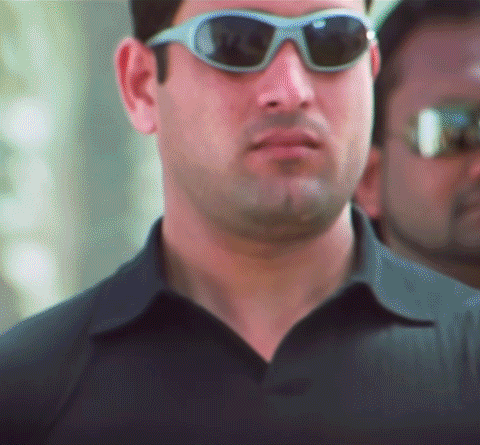
So I was taken aback, because the general sentiment for KJo movies should be ‘It’s so shit, but I love it’ - that is a sentiment I can live with because we all have our guilty pleasures.
KJo has his audience who love the shit he pulls off every time he ‘directs’ a film with toxic masculinity, regressive female leads , justifying infidelity (always the answer to unhappy marriages) , glorifying Indian culture, where he adds 30 mins of melodrama and lectures to make the characters redeem themselves. Kjo’s movies are as lame as they can be, but people love them. I get it - ‘this shit is so bad, it’s so good’ category of films. Guilty pleasures are exactly this!

So sell me his new offering in exactly this manner - but all reviews and social media comments were glowing words of praise of how he has addressed today’s issues and it’s a progressive film. Are people suffering from amnesia or have they not watched better Bollywood films? Because I have a whole list of films you should watch that actually deal with ‘progressive’ mindsets - way before Kjo’s time!

Rani is a feminist. A FL as feisty news anchor who gives a 5 min lecture on men’s gaze, objectification of women and rape culture, but does an absolute U-turn 5 mins later by objectifying a handsome man in front of her. This is gender equality. Tit for Tat.

Wearing open back blouses to work is sign of new age feminism (Will I get trolled for sounding old school - has KJo ever stepped inside a corporate workspace - who dresses like Rani does?) What’s next? Women CEOs wearing bikinis? And why not get all men to dress like Rocky Randhawa - that would be peak gender equality in dress code at workplace.
Infidelity is the answer to all unhappy marriages. Remember KANK? Yes, let’s repeat that here, but let’s twist it into unrequited love between the senior citizens. Then add memory loss and illness excuse to get the 80yr old grandpa smooch his 75yr old ex-lover in front of his wife and entire family. The issue is not old age love, age is never a restriction to fall in love, the issue here is infidelity. But if this isn’t cringe enough, let’s completely destroy the most beautiful romantic number in Bollywood by playing it in the background to immortalise infidelity and later lust under the garb of love.

Let’s get back to our feminism torch bearer Rani, who has now jumped from knowing the guy for two meetings to lusting over him. She is honest with herself (not with Rocky mind you, because at no point have they had any conversation about themselves) that she is in it purely for the physical attraction, it’s just a fling for her. She is an elitist , feminist, Colombian grad, Bengali Girl (who has a terrible Bengali accent) and the crude, can’t speak English well, Gucci/Fendi wearing, Ferrari driving, protein shake drinking, loud Punjabi boy doesn’t match up to her standards. Kjo’s new level of feminism - make women pull the exact shit on men that men have put women through for decades. Tit for Tat! Gender Equality.
Btw at this point I still don’t know why Rocky loves Rani - love at first sight is always about the looks and physical attraction, so convince me why he loves her - because isn’t he this walking-talking green flag just by being understanding of his grandpa’s feelings and calling out Rani checking him out. A walking green flag who gets his grandpa’s ex-lover and his grandpa together to help his grandpa get better - because love is the cure for all illnesses. All doctors and medical researchers have been wasting their time on getting degrees and super specialisations - please enter Kjo’s school of love.

So now Rani realises she is in love - when and why and what changed her feelings from lust to love - I do not know. She drives on a 4-lane highway in the opposite direction - woman should have died there for her reckless driving, but she lives to propose to Rocky on a f&*king Highway! Bollywood I love you for pulling off this shit.
This is supposed to be the pivotal point in their relationship where she professes her love to him, going down on one knee (because hey you see role reversal - she is the feminist, the alpha female) and telling Rocky everything that HE IS NOT , listing her resume and her exes’. Therefore implying he doesn’t deserve her, but she is taking the high road and still falling for him. All the reasons she lists that she loves about him are actually about his physical aspects = Lust. She doesn’t list one meaningful quality that she actually ‘loves’ about him.
It is at this point that I gave up on the film, because after this RRKPK became a collation of scenes dedicated to social media trending topics:
1. Women burdened with household work
2. Women not liberated enough to pursue their dreams
3. Women being fat shamed
4. Cancel culture
5. Men being shamed for pursuing classical dancing (KJo research FFS - 50% of India’s top kathak dancers are males right from 1940s! )
Each topic got 1-2 scenes, tweets converted to preachy dialogues uttered by our ‘feminist’ queen and zero closures or character growth.
The only thing that works in this movie - is Ranveer , not his character, but him! He is effortless in this role, his comic timing is superb, needs some work on emotions.

Alia is a shadow of her awesome self on screen post her marriage to Ranbir. It hurts to say this, cause I have loved her in all her movies except SOTY.
Can people age gracefully, I couldn’t bear to look at Shabana Azmi and Jaya B - former was gorgeous as hell in her younger days, now is swollen with all the Botox fillers! Jaya has forgotten to act completely. Dharmendra should not even be acting anymore.
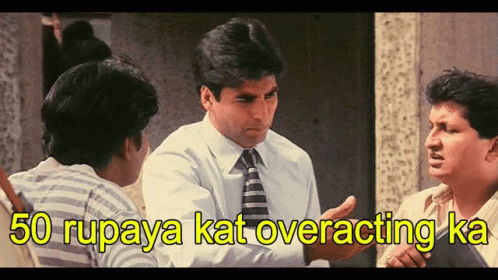
What was the point of rest of the cast? Only Alia’s dad was a decent act.
The one thing I absolutely love in KJo movies is the music and songs! These were crap too. What Jhumka? Because ruining all the songs from ‘The Golden’ decade of Bollywood was not enough, so they made a terrible mashup of Badtameez Dil & Jhumka Gira Re and killed both the songs in one go! Takes some skill doing this - well done!
Why this long rant if I disliked the movie so much, that too KJo movies? I wouldn’t have written one, if the reviews and comments were honest about the movie being average, typical entertainment; but the moment people praised it to nth level of being socially relevant with feminist heroine and gender equality - they deserved to be called out for their shallow thought process thinking that KJo actually cares about any of this stuff.
Worst people think this is ‘quintessential’ Bollywood. Please watch better films - like Amitabh’s roaring 70s, the romance films of 90s, the fun comedies, the glorious slice of life films from Hrishida, the Yash Chopra multistarrers - that’s quintessential, genuine, charm of Bollywood.

Lastly before I wrap this up - RRKPK when literally translated is Love Story of Rocky and Rani. I spent 2.5 hours on this shit show and I still don’t know the answer to why and how they fell in love! They didn’t have one decent conversation about themselves! The latter half is about them wooing their families. The film should have been aptly titled ‘Randhawa and Chatterjee Ki Prem Kahaani’ - It’s all about loving your family - K3G Part 2!

#rocky aur rani ki prem kahani#rrkpk#karan johar#ranveer singh#alia bhatt#shabana azmi#Jaya Bhaduri#dharmendra#film review#honest review#Bollywood#kabhi khushi kabhie gham#hindi films
42 notes
·
View notes
Text



Pakistani cinema made history last year when Joyland (2022), written and directed by Saim Sadiq, became the first Pakistani film to premiere at the 2022 Cannes Film Festival, receiving a standing ovation and international acclaim. During its festival circuit, Joyland received several prizes and was shortlisted for the Academy Awards but was banned in its home country. Despite previous clearances from federal and provincial censorship boards, distribution of the Punjabi-language film was halted by the Pakistani government last November as the film consisted of “highly objectionable material” including scenes of LGBTQ+ intimacy.
While Pakistan’s Federal Censor Board quickly reversed the nationwide ban three days later with “minor cuts” to the film’s more controversial scenes after immense criticism for censorship on social media, the Punjab Censor Board ultimately prohibited the film from being screened in the province of Punjab, where the film is set and filmed.
Now, New Yorkers can watch the contested film at Manhattan’s Film Forum theater.
83 notes
·
View notes
Text
The murder of a politician in a bustling area in India's Mumbai city has sent shockwaves across the country.
Baba Ziauddin Siddique, 66, was shot on Saturday night near his carwhile he was leaving his son's office. He died later in hospital.
The killing of Siddique, an influential politician who was part of the coalition governing Maharashtra state - of which Mumbai is the capital - has set off a political blame-game.
The motive for the murder is not clear yet, but for many it has brought back memories of the 1990s, when politicians and film stars were frequently targeted by Mumbai's underworld.
Police have arrested three people so far and say investigations are continuing. Local media reports say the arrested men are part of a notorious gang whose leader is currently in jail.
Who was Baba Siddique?
Born in the eastern state of Bihar, Siddique migrated to Mumbai at the age of five with his father, a watchmaker.
He started his political career in the 1980s as a student leader with the Congress party, soon leading its youth wing in Mumbai. He then entered local council politics before being elected to the state’s legislature three times in a row and becoming a minister in 2004 for about four years.
In February, he left the Congress to join the Nationalist Congress Party which, along with Prime Minister Narendra Modi's Bharatiya Janata Party (BJP) and the Shiv Sena, currently governs state.
Apart from his political activities, Siddique also made headlines for his glitzy iftar parties held during the Muslim holy month of Ramadan which were attended by top Bollywood stars.
It was at his iftar party in 2013 that superstars Salman Khan and Shahrukh Khan ended their much-discussed rift with a hug - that propelled "the annual Siddique affair into a must-watch event on the city’s social calendar", Midday newspaper wrote in 2016.
How was Siddique killed?
The politician was shot outside his son’s office as he was about to enter his car in the busy Bandra area.
Police said three shooters fired six-seven rounds, hitting Siddique's abdomen and chest, and fled the scene. A bystander was also injured as a stray bullet hit his leg.
Investigators said they had recovered two pistols and 28 live rounds of ammunition from the arrested men.
Siddique had three police guards - local media reported his security was upgraded days ago - but the suspects reportedly distracted them by setting off a "smoke firecracker".
What is the state of the investigation?
Police have been granted custody of the arrested men for a week. They say they are on the lookout for their accomplices.
“We have set up 15 teams and investigation is on to identify who provided logistical support to the shooters,” senior police official Datta Nalawade said.
While the police have not confirmed it, several reports citing sources have linked the arrested men with the notorious Bishnoi gang. The gang's leader Lawrence Bishnoi is an accused in several cases and is currently in a high-security prison in Gujarat state.
Within hours of the shooting, a man claiming to be a member of the gang posted on Facebook that they were behind Siddique’s killing. Police have not yet confirmed the authenticity of the post.
Though Bishnoi has been in jail since 2015, he frequently makes news. Many social media accounts claiming to belong to him or his associates have often posted his selfies from jail. He even gave interviews to a TV channel in 2022, prompting an investigation.
Many of the reports on Bishnoi are based on police sources and it’s not clear how he conducts the gang's operations while in prison.
The gang's name popped up in connection with the murder of Punjabi rapper Sidhu Moosewala in 2022.
In April, police arrested two gang members for allegedly firing shots outside the apartment of actor Salman Khan in Mumbai.
On Monday, the Canadian police also said it believed the Bishnoi group had connections to Indian government agents who were using the gang to target Sikh separatists on their soil. India has not officially responded to the police claims.
What else has happened?
Siddique’s killing is the first major assassination of a politician in Mumbai since the 1990s when high-profile killings of politicians, businessmen and Bollywood celebrities by criminal gangs of the Mumbai underworld were not uncommon.
Local media reports said he had received a death threat two weeks ago, which led to his security being upgraded.
His killing within days of that has put the state government on the backfoot, with Maharashtra set to hold assembly elections soon.
Congress president Mallikarjun Kharge called the murder “a complete failure of law and order in Maharashtra”, and Delhi's former chief minister Arvind Kejriwal said the incident had scared not only the people of Maharashtra “but the entire country”.
Chief Minister of Maharashtra Eknath Shinde has defended his government.
“[The culprits] will not be spared no matter who they are, be it the Bishnoi gang or any underworld gang… Those who are receiving threats, their safety is the state government’s responsibility and it will fulfil its responsibility,” he said.
4 notes
·
View notes
Text
Creative Review 06

Here's a quick look back at the Creative happenings and hot topics of the week.
#CreativeReview is a one-stop cheat sheet of everything that happened this week in the digital media world - it's a weekly summary for creatives, written by creatives and it’s a free/quick read with no registration and we won't add you to some annoying list that's impossible to unsubscribe to promise.
Trailer Beat
youtube
Apple TV+; June 28
Idris Elba, Archie Punjabi
Told in real-time, Hijack is a tense thriller that follows the journey of a hijacked plane as it makes its way to London over a seven-hour flight, and as authorities on the ground scramble for answers.
youtube
Sony Pictures, In theaters June 23
Jennifer Lawrence, Andrew Feldman, Matthew Broderick
Maddie (Lawrence) thinks she’s found the answer to her financial troubles when she discovers an intriguing job listing: wealthy helicopter parents looking for someone to "date" their introverted 19-year-old son, Percy, and bring him out of his shell before he leaves for college. But awkward Percy proves to be more of a challenge than she expected, and time is running out. She has one summer to make him a man or lose it all.
youtube
Warner Bros. Pictures, In theaters December 25
Taraji P. Henson, Danielle Brooks, Colman Domingo, Corey Hawkins, Halle Bailey, H.E.R., Fantasia Barrino
A remake of the classic film showcasing the extraordinary sisterhood of three women who share one unbreakable bond in “The Color Purple.” This new take on the beloved classic is directed by Blitz Bazawule (“Black Is King,” “The Burial of Kojo”) and produced by Oprah Winfrey, Steven Spielberg, Scott Sanders, and Quincy Jones.
Social Media Tips & Resources
Brandy Johnson breaks down some helpful social media tips this week:
How to Find your target audience and enhance your social media strategy on Instagram










Understanding Instagram's Algorithm for Beginners

Instagram's algorithm is pivotal in determining what content users see on their feeds. It constantly evolves to provide a personalized and engaging experience for individuals.
👉Here's an analysis of Instagram's algorithm and its key components:
✅Engagement: The algorithm prioritizes content that generates high levels of engagement, such as likes, comments, saves, and shares.
✅Relevance: It analyzes post engagement, search history, and user interactions to understand preferences and deliver personalized content.
✅Relationships: The algorithm prioritizes content from accounts that a user frequently engages with, including posts from friends, family, and accounts they interact with regularly.
✅Recency: Instagram aims to provide users with the most recent posts to keep them up to date with the latest content.
✅Usage: The algorithm considers how often a user opens the app, the duration of their sessions, and the types of content they engage with.
✅Following: The algorithm considers the accounts users follow and their content. If a user follows accounts with similar content themes, Instagram is more likely to show them related posts.
✅Explore Page: The Explore page, powered by the algorithm, offers personalized recommendations to users based on their interests and interactions. It showcases content from accounts that users may not follow but align with their preferences.
Here are a few key takeaways:
🔥Focus on creating engaging content that sparks conversations and encourages interactions from your audience.
🔥Nurture relationships with your followers by engaging with their content and responding to comments.
🔥Post consistently to maintain a presence and increase the chances of your content being seen.
🔥Use relevant hashtags to expand your reach and connect with users interested in your niche.
🔥Experiment with different content formats, such as videos, Stories, and carousels, to keep your audience engaged.
🔥Monitor your analytics to gain insights into what types of content perform best and adjust your strategy accordingly.
Creative Showcase
Abu Dhabi: One Summer Isn't Enough
youtube
As the Emirate states recover from a COVID-influenced downturn in tourism, it’s intriguing to see how Abu Dhabi’s Department of Culture and Tourism – Abu Dhabi (DCT Abu Dhabi) is positioning the UAE’s capital city.
DCT is achieving this positioning through its “One Summer Isn’t Enough” campaign. The seasonal campaign has launched across 12 markets under the Experience Abu Dhabi destination brand, with a series of vibrant and light-hearted spots that showcase Abu Dhabi as the best place to experience summer highlighting a diverse range of indoor experiences, unmissable events, and unbeatable summer offers, and the emirate’s wide range of indoor attractions will ensure that visitors stay cool and comfortable.
Liquid Death: Recycled Plastic Surgery Center
youtube
Ozempic Queen or Buccal Fat Removal? Regardless of how you identify, Liquid Death is clearly playing into the beauty trends of the moment by focusing their latest campaign on plastic recycling, or rather, Plastic Surgery Recycling in a new spot starring Whitney Cummings.
Most recycling facilities send our plastic to landfills or oceans because it’s not actually profitable to recycle. So what should we do with all of this plastic trash? Introducing the Liquid Death Recycled Plastic Surgery Center. A revolutionary new approach to useless plastic garbage.
Learn more at: http://liquiddeath.com/plasticsurgery
McDonald’s “Sí Pica o No Pica”
tumblr_video
McDonald’s is asking Gen Z fans “Sí Pica o No Pica” with its newest Spicy Menu campaign helmed by Colombian American director Victoria Rivera and produced by SLMBR PRTY in collaboration with Alma.
Rivera’s approach captured the candid opinions and reactions of a diverse cast of Gen Z friends as they try out the McSpicy sandwiches and Chicken McNuggets® in various environments.
The free-flowing conversations among the friends provide honest and unscripted reactions to the level of spiciness, with ad-libs in Spanglish polling their friends for their opinions on the spice level.
Goody: A different sauce for every artist صلصة غير لكل فنان
tumblr_video
In food brand Goody’s latest campaign, pasta is their canvas, in which consumers can express themselves to come out with a masterpiece/painting.
Goody will accompany passionate foodies with a rich range of pasta sauces to help them shine, and add a sprinkle to their Artistic masterpieces, each carrying an artistic story of their own.

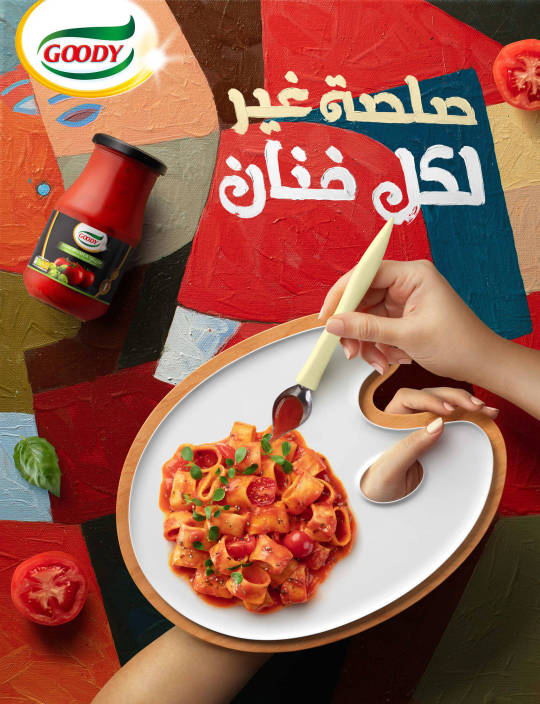
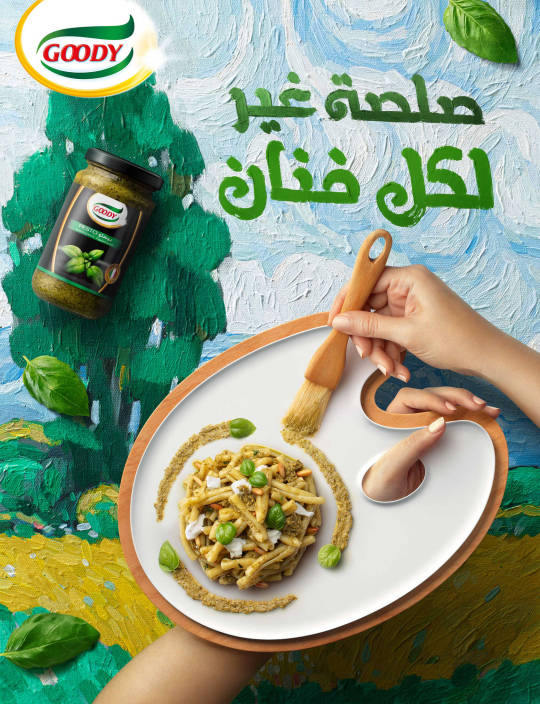
Don’t Eat the Homies: Nature is a runway
Birkman Agency took the concept of an ordinary runway and flipped it on its head to promote the athletic brand, Don’t Eat the Homies, by embracing the wild and untamed beauty of the great outdoors. Birkman & team hit the trails armed with a treadmill, models ready to strut their stuff, and a whole lot of 80s spirit.



tumblr_video
Heineken Champions Cup Final Arrivals Billboard
Heineken helped a Leinster superfan send a message to Stade Rochelais ahead of the Heineken Champions Cup Final in Dublin.
Heineken believes the bigger the rivalry, the better the rugby. That’s never been truer than this weekend as Leinster Rugby took on reigning champions Stade Rochelais in the final of the Heineken® Champions Cup in the Aviva Stadium, Dublin.
After losing to La Rochelle in the final last year, Leinster will be doing everything in their power to get the win and secure their fifth Heineken Cup. And so will their fans, it seems.
Heineken Ireland made superfan Colin Fennessy’s dream come true by helping him paint his cheeky message to La Rochelle Head Coach Ronan O’Gara (or ROG as he’s known locally) at scale in Ballyboughal Airfield, located right next to Dublin airport.
“Never too late to turn the plane around, ROG!” is big enough to be read from 30,000 ft and will be visible to all planes flying into Dublin on the La Rochelle flight path this weekend.
The message from Colin was picked up as part of Heineken’s Love Rivalry campaign where fans were invited to send cheeky voice messages to the opposing team on match day.
The mammoth message measures 15M X 10M and was created with *eco-friendly paint. The message is designed to be the first thing rugby fans see on their approach to Dublin City.
LeBron James x Taco Bell: Taco Tuesday

The trademark on the phrase “Taco Tuesday” is really burning Taco Bell and LeBron James’ burritos. Now, the two have joined forces to combat the interdict on the use of the moniker in marketing material.
In a new ad, LeBron James laments being bleeped in a candid vertical video where he shouts, “It’s Taco Tuesday!” as he continues to be bleeped throughout the ad—but he’s grateful Taco Bell is doing something about it.
youtube
15 notes
·
View notes
Text
Mississippi Masala: The Ocean of Comings and Goings
By Bilal Qureshi MAY 25, 2022
often remark that my Punjabi parents immigrated to the American South woefully unaware that they’d brought us to a place with an incurable preexisting condition. Racism doesn’t belong exclusively to the South—the former Confederacy—but it was implemented at industrial scale across the region’s economic, political, and cultural life. Alongside this landscape’s sublime natural beauty—rivers, fields, and bayous—sits the history of America’s unsparing brutality against its Black citizens. On the other side of the world, in South Asia, as well as among its global diasporas, anti-Blackness is embedded in ideas of colorism and caste, in tribal imaginaries and policed lines of “suitable” marriages.
The possibility to live—and to love—across racial borders is the theme of Mira Nair’s extraordinarily prescient and sexy second feature film, Mississippi Masala (1991). Three decades later, it speaks to a new generation as groundbreaking filmic heritage—but also with an almost eerie, prophetic wisdom for how to live beyond the confinements of identity and color. Even by today’s standards, the film is a radical triumph of cinematic representation, centering as it does Black and Brown filmmaking, acting, and storytelling. It is also a genre-defying outlier that would likely be as difficult to get financed and produced today as it was then. Part comedy, part drama, rooted in memoir and colonial history, the film that Nair imagined was a low-budget independent one with global settings and ambitions. The notion of representation—perhaps more accurately described as a correction of earlier misrepresentations—wasn’t its point or its currency. Race was its very subject. Nair has said she wanted to confront the “hierarchy of color” in America, India, and East Africa with the film—the kinds of limitations that she had experienced firsthand by living, studying (first sociology, then film), and making documentaries in both India and the United States. In a shift that began with her first feature film, Salaam Bombay! (1988), Nair set out to transform those real-world issues into fictionalized worlds, translating her sociological observations into works suffused with beauty, music, and, in the case of Mississippi Masala, humid sensuality.

Nair first engaged with the questions at the heart of the film when she came to the United States from India to study at Harvard in the mid-1970s. As a new arrival to the country’s color line, she has recalled, both its Black and white communities were accessible to her, and yet she belonged to neither. The experience of being outside that specific American binary would be a formative and fertile site of dislocation for the young filmmaker. Nair trained in documentary under the mentorship of D. A. Pennebaker, among others, and her first films were immersive explorations of questions that haunted her own life. The pangs of exile and homesickness for lost motherlands became the foundation of So Far from India (1983), and the boundaries of “respectability” for women in Indian society the subject of India Cabaret (1985). Salaam Bombay!—made in collaboration with her fellow Indian-born classmate, the photographer and screenwriter Sooni Taraporevala—carried her Direct Cinema training to extraordinary new heights. Working, from a script by Taraporevala, with nonactors on location in the streets of Mumbai, Nair found a filmic language that could merge the rigor of realism with the haunting emotion of fiction. It would become the creative model for Nair and Taraporevala’s translation of the real-life phenomenon of Indian-owned motels in the American South into a spicy cinematic blend of migration, rebellion, and romance.
During research trips across Mississippi, Louisiana, and South Carolina that Nair made in 1989, she discovered that many of the Indian motel owners in the South had come to the United States from Uganda following their expulsion by President Idi Amin in 1972. Ten years after the East African country gained its independence from British rule, Amin had blamed his country’s economic woes on its privileged and financially successful South Asian community. In the racial politics of empire, the British had privileged the Indian workers they had imported to East Africa, creating racial hierarchies Amin now wanted to destroy by way of politicizing race anew. In a line that is repeated in the screenplay, the mission was “Africa for Africans,” and for tens of thousands of Asian families, it was an uprooting and dislocation from which some would never recover.
In Mississippi Masala, the classically trained British Indian actor Roshan Seth plays Jay, the immigrant father who is the focal point of the “past” of the film’s dual narrative, which is beautifully balanced in the way that it interweaves the perspectives of two generations. In the film’s harrowing overture, Jay—along with his wife, Kinnu (Sharmila Tagore), and their daughter, Mina (Sarita Choudhury)—is being forced to flee Kampala, and he laments that it will always be the only home he has known. With stoic reserve, holding back tears, Seth conveys the gravity of the loss, as the camera captures the lush beauty of the family’s garden and the faces of those they must leave behind. Throughout the film, as Kinnu, Tagore—an acclaimed Indian film star and frequent Satyajit Ray collaborator—is a composed counterpoint to Seth’s troubled Jay in her character’s strength and resilience. When the film picks up with the family two decades later, Kinnu is shown managing the family’s liquor store, while an aging Jay writes to petition Uganda’s new government to reclaim his lost property. Nair’s camera pans up from his writing desk to reveal through his window the parking lot of a roadside Mississippi motel. This is where Jay works and exists in a permanent state of nostalgia, until he is jolted awake by Mina’s demands for a home and a life of her own.
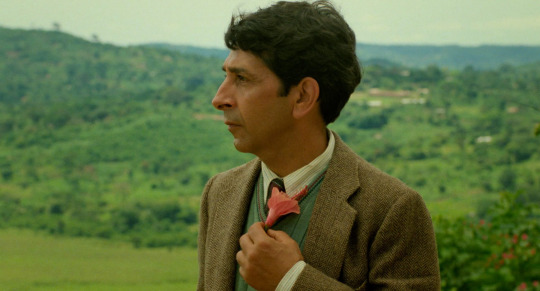
Even as Jay dreams in sepia-toned memories, the film itself never descends into saccharine longing or scored sentimentality. The rigor of the research and on-location filmmaking in both Mississippi and Kampala is reflected in an unvarnished and immersive visual style. While Nair herself clearly understood the fabric of the lives of the Gujarati Hindu families she was portraying, she has discussed how Denzel Washington became a critical collaborator in ensuring that southern Black life was rendered with equal attention to detail, cultural specificity, and dignity. The result is a film whose homes and communities are etched with a palpable sense of reality.
All of Mississippi Masala’s disparate threads are bound together by a distinctly sultry southern love story, which naturally remains the best-remembered feature of the film. The meet-cute of Mina and Washington’s character, Demetrius, is quite literally a traffic collision, a not-so-subtle suggestion that, without a bit of movie magic and melodrama, these two southerners might never have been maneuvered into the exchanged numbers and glances, and palpable wanting, that still burn the screen today. The film is fueled by the gorgeousness and megawatt charisma of both its stars, the young Washington paired with Choudhury in a prodigious debut as a woman at the edge of adulthood—her mane of wavy hair, their sweaty night of dancing to Keith Sweat, aimless late-night phone calls, dark skin in white bedsheets, secret meetings, consummated desires.
In the background of the R&B song of young, electric love are the film’s quieter, deeper notes on migration. A string leitmotif by the classical Indian violinist L. Subramaniam recurs whenever the vistas of Lake Victoria across the family’s lost garden in Kampala appear on-screen in brief flashbacks. Nair’s mastery with music has only deepened with time, resulting in films that integrate archival and original music with a free-form alertness that is distinctly her own. Both for the African American people living amid strip malls in the dilapidated neighborhoods of a region to which their ancestors were brought by bondage, and for the Indian families forced by Amin to flee their homes, exile is expressed in stereo. As Jay pines for the country he lost, Demetrius’s brother dreams of visiting Africa and saluting Nelson Mandela—disparate but recognizable longings and family histories shared over a southern barbecue, American bridges.

There wouldn’t be racial borders, however, if they weren’t policed, and the policing authorities here come from across the racial spectrum. When Mina and Demetrius’s relationship is discovered by nosy Indian uncles, those boundaries flare up. From the Black ex-girlfriend who asks why the good Black men can’t date Black women, to the Indian uncles who barge into Demetrius and Mina’s hotel room, to the gossiping aunties who during phone calls mock Mina’s rebellious scandal, there is a veritable chorus of condemnation. It is portrayed with great comedic timing and wit, including from Nair herself, who delivers some of the sharpest lines of disapproval in the role of “Gossip 1.” But the implications of those judgments remain unfunny by design. The film’s remarkable achievement is the way it never buckles under the thematic weight of these uncomfortable truths. Nair always delivers her cerebral punches with a lightness and warmth that are precisely calibrated. These are the markers of a filmmaker in full control of the tone, color, production design, and, always, music to accompany the emotional demands of her material, and that facility has only gotten sharper in such masterpieces as Monsoon Wedding (2001).
Mississippi Masala showed at festivals in late 1991 and was released commercially in American cinemas in February 1992, within weeks of Wayne’s World and Basic Instinct. Working outside Hollywood’s conventions, Nair joined an extraordinary flowering in independent filmmaking that continues to be celebrated. The year 1991 had been a landmark one for Black cinema already, with the release of Julie Dash’s Daughters of the Dust, Mario Van Peebles’s New Jack City, and John Singleton’s Boyz n the Hood. Spike Lee’s opus Malcolm X, with Washington in the title role, would be released in the U.S. in late 1992. Nair’s film was shown at the same 1992 Sundance Film Festival at which a landmark panel about LGBTQ representation heralded a movement, named New Queer Cinema by moderator B. Ruby Rich, devoted to reclaiming stories of love and suffering from Hollywood’s gaze. These were parallel currents that echoed larger shifts and openings happening in global culture. The collapse of the Soviet Union, the end of apartheid in South Africa, India’s economic liberalization, and the rise of a youthful southern Democrat in the U.S. following a decade of Republican rule were stirrings of a new order. The possibilities were being felt all over the world as Nair’s film of southern futures arrived. Described by the New York Times at the time as “sweetly pungent” and by the Washington Post as a “savory multiracial stew,” Mississippi Masala opened in American cinemas to rave, if exoticizing, reviews, less than a decade after Richard Attenborough’s Gandhi and Steven Spielberg’s portrayal of Indian characters eating monkey brains during a ritual dinner in Indiana Jones and the Temple of Doom. Realistic international cinema featuring everyday South Asian life—as opposed to the Indian musical tradition or Hollywood’s tropes about foreignness—had almost no precedents or peers at the time. The depiction of South Asian characters as ordinary working-class Americans navigating questions of family, money, and love remains a radical achievement. Mississippi Masala also manages to decenter whiteness altogether. In a film about racial hierarchies, white characters appear only in the background, as the motel guests, patrons, and shopkeepers of Greenwood society. By design, this is first and foremost a film about Mina and Demetrius, and the families and communities that formed them. Despite all the extraordinary accomplishments in the streaming age by the current generation of filmmakers of color, Mississippi Masala’s layered portrayal of race and love still feels unparalleled. To hear its characters speak candidly about the real lines that divide them, and reflect on the costs of crossing those lines, is to recognize the rigorous thinking—and living—that informed the screenplay. Even more disappointing than the lack of contemporary equals to the film, perhaps, are the offscreen parallels in South Asian communities like my own, where colorism and anti-Blackness are stubborn traditions yet to be fully dismantled. Stories of interracial love are still rarely told on-screen, and these relationships—the masala mixes—are still not visible enough to become as normalized as they deserve to be.
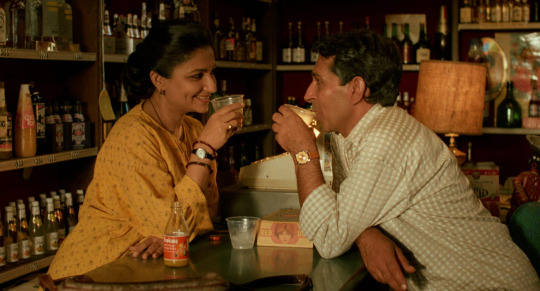
One of Nair’s first films, So Far from India, was filmed between New York City and Gujarat. It opens with a folk musician in the streets of Ahmedabad, a sequence that serves as a prelude to the film, about an Indian immigrant and the wife he has left behind. Nair, as narrator, translates his singing about the ocean of comings and goings. With Mississippi Masala, Nair positioned herself as both a great chronicler and a great navigator of that vast ocean of comings and goings. America is one of Nair’s homes, and she has made several films about the immigrant experience there, including her adaptations of Jhumpa Lahiri’s The Namesake (2006) and Mohsin Hamid’s The Reluctant Fundamentalist (2012). Each has sought to look at the country through the eyes of those usually on the margins in order to dramatize and problematize the idea of the American dream. It is these poetic and cinematic ruminations on identities in flux that feel like her most enduring, almost personal, gifts to hyphenated viewers like myself.
When I was younger, I thought Mississippi Masala embodied Mina’s rebellion, the promise of independence, and the freedom to choose whom and how to love. But now, twenty years after I first saw the film, at university, Jay’s longing for home and his incurable displacement feel equally, achingly resonant. With the limitations of America laid bare by the gift of adulthood, migration is no longer only a hurtling forward toward the rush of freedoms; it is now also the unknowable costs borne by my parents, the homes and selves they left behind.
The film’s closing credits, braiding Jay’s return to Kampala with glimpses of Mina and Demetrius kissing in the warmth of the southern sun, capture Nair’s exquisite feat of balancing—and blending—in Mississippi Masala. For a film traversing so many geographies and registers, there is finally a seamless harmony between father and daughter, between tradition and future, between here and there. As seen anew in restored colors, Mississippi Masala endures not for its spicy and pungent aromas of cultural specificity or representational breakthrough but for this profound commitment to multiplicity. It is a timeless song for and to those who live—and love—in multitudes.

#Criterion Collection#Mississippi Masala#Mira Nair#Charles S. Dutton#Denzel Washington#Roshan Seth#Sarita Choudhury#Sharmila Tagore#Joe Seneca#Bilal Qureshi
5 notes
·
View notes
Text
Indian Rap Heroes DIVINE & Karan Aujla are Anime Action Stars in "HISAAB" Video

DIVINE and Karan Aujla are heroes in the fast-growing Indian hip-hop scene. The groundbreaking duo puts their power into action in "HISAAB," a new anime-influenced video from their new collaborative album Street Dreams. "HISAAB" mixes traditional Indian instrumentation with a hip-hop pulse, as DIVINE and Karan Aujla trade bars–DIVINE rapping in Hindi, Karan Aujla rapping and singing in Punjabi–to examine the price of fame and the responsibilities incurred. Directed by Debjyoti Saha for Goppo Animation, the video for "HISAAB" is a visually-striking, action-packed, Anime-influenced short film. DIVINE and Karan attempt to escape from a surreal asylum, full of autonomous soldiers and giant cobra snakes, in an effort to save their freedom and sanity in the harsh world. The video surpassed 1 million views in just 12 hours and is currently in the Top 10 of YouTube's Trending Chart.
youtube
Last week, DIVINE and Karan Aujla shared Street Dreams, a 7-track effort that demonstrates why they are among the most exciting artists in the Indian scene. Out now via Mass Appeal India, Street Dreams had an extremely successful debut, reaching #1 on Apple Music within 24 hours of release, and taking over the number one spot on Apple Music's Album Charts in 40 countries, including India, Canada, New Zealand, and Australia. All seven songs from Street Dreams charted on Spotify's Daily Top Songs in India, and are currently trending on Instagram.
is a relentless effort, bringing bilingual bars that express sentiments that need no translation. The album features production from Western heavy-hitters like Boi-1da, WondaGurl, Harry Fraud, Leven Kali, and Trox, who deliver premium productions for Karan and DIVINE to annihilate, along with hip-hop producers from the Indian scene. "Hisaab" finds the two artists counting their myriad accomplishments in 6/8 time, taunting any comer who can't match their quick maths, while "Top Class / Overseas" lays playful strings atop sliding 808s as DIVINE and Karan proclaim their valedictory status. "Yaad," meanwhile displays a softer side of the duo, as they trade off vocals with Indian-Canadian singer Jonita Gandhi.
Also among the highlights is "100 Million," the tape's lead single and music video, which made waves across the globe. Defined by nostalgic hip-hop production reminiscent of Y2K-era Dr. Dre, in this case produced by American producer Trox (50 Cent, Cordae), “100 Million” is an anthem for those with grand dreams, the two icons reflecting on the enduring habits that propelled them to greatness. The song arrived in mid-January, with a video filmed in Dubai and directed by Karan Aujla’s long-time collaborators Rupan Bal, Dilpreetvfx and Anmol Raina. The song and video immediately became a huge success–the song reached the #1 spot of the YouTube Trending Charts in India, and reached the Top 10 in countries including Canada (#2), New Zealand (#4), UK (#6), Australia (#8) and the UAE (#8). Overall, the song racked up over 21 million YouTube views to date, as well as over 6 million Spotify streams.
Karan Aujla and DIVINE have individually topped several charts across India with their albums and songs such as Karan's “Softly”, “White Brown Black”, “Mexico,” and “Players,” and DIVINE's “Mirchi”, “359 AM”, “Baazigar” (80 million YouTube views), and “Kaam 25” (65 million YouTube views). Their upcoming collaborative project is the first of its kind in the Indian music space and is poised to be a landmark moment in Indian music history.
With Street Dreams out now, the dynamic duo prepares to make their presence felt on American shores. Stay tuned for more videos and announcements from DIVINE and Karan Aujla in the near future.
#india rap#indian hip hop#indian rap#desi hip hop#desi music#desi#music#soundcloud#youtube#artist#spotify#musician#rapper#culture#rap#art#karan aujla#divine#Youtube#Spotify
2 notes
·
View notes
Text
Nimrit Kaur Ahluwalia To Make Her Feature Film Debut With Guru Randhawa
Nimrit Kaur Ahluwalia steps into the world of cinema with the much-anticipated Punjabi film, #ShaunkiSardar, alongside the charismatic #GuruRandhawa!
Get ready for a cinematic treat that promises romance, drama, and everything in between. 🌟
Link to the full story: https://www.theomenmedia.com/post/nimrit-kaur-ahluwalia-to-make-her-film-debut-in-shaunki-sardar-opposite-guru-randhawa

#Shaunki Sardar#Guru Randhawa#Nimrit Kaur Ahluwalia#Film Debut#Punjabi Cinema#Bollywood#New Release#Movie Magic#Cinema Lovers#Entertainment News#Actress#Singer#Shaunki Sardar 2025#Movie Announcement#Film Industry#Bollywood Buzz#Guru Randhawa X Nimrit
0 notes
Text
Get to Know Me Better!
Tagged by @wo-der-horizont-beginnt - thanks!
Three Ships Steed/Emma, Castle/Beckett, Tod/Rudolf (in some productions; my musical shipping is production-dependent and gets confusing even to me)
First Ship: I'm not even sure. Probably something from Star Trek: TNG when I was like 10, but I had a few different ships there and I don't remember which came first.
Last Song: One Day More
Last Movie: Peter Pan (2003)
Currently Watching: The boot of Les Mis that Anton Z. uploaded a few days ago. Whoever filmed it was so clearly there for One Reason Only; it's kinda cute actually.
Currently Consuming: Water
Currently Craving: Protein and spice. There's a new Punjabi restaurant a couple blocks from my apartment and I'm thinking of getting takeout for dinner.
Tagging: I never know who wants to be tagged in these things. @wenn-ich-tanzen-will, @jon-withnoh, @blorbinho, do y'all feel like doing this? Anyone else?
4 notes
·
View notes
Text
Watch Legendary love story ghazal song Lafz Bheege Hain
Sufiscore celebrates an epic Indian love story, an ‘amour eternal’ on the new release Lafz Bheege Hain (“Words Drenched in Tears”). The album features lyrics from the esteemed contemporary poet, Ajay Sahaab with beautifully sung melodies from lead vocalist Pratibha Singh Baghel. The songs on Lafz Bheege Hain follow the story of unrequited love involving two eminent writers from India’s social justice-oriented Progressive Writers Movement, Punjabi Amrita Pritam (1919-2005) and Sahir Ludhianvi (1921-1980). Pritam, a novelist, essayist and poet, discusses her unrequited love for Ludhianvi, the poet and film lyricist, in her 1977 autobiography ‘Rasidi Ticket’ (a.k.a. The Revenue Stamp).
youtube
“There is a saying in India that if you want to express love, you resort to Urdu,” declares poet Ajay Sahaab. Sahaab drew on his lifelong passion for Urdu to evoke a familiar “tear-drenched” story that has almost acquired the status of a legend or folk tale.
Lafz Bheege Hain consists of five songs, modern in sound and conception, yet following the traditional form of the ghazal: a poem with rhyming couplets in prescribed patterns, usually sung in Urdu, the “love language” par excellence of the subcontinent. This great love story between Amrita Pritam and Sahir Ludhianvi has been depicted in literature and film — and in that spirit, director Parasher Baruah has created a sequence of videos to accompany all of the ghazals of Lafz Bheege Hain, featuring famed actors Prachi Desai and Som Chattopadhyay in the leading roles.
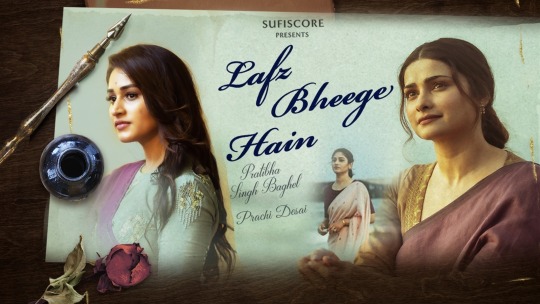
The emotions summoned by this love story”, says singer Pratibha Singh Baghel, “are held in common throughout the world. Those feelings of love and separation and sadness are the same everywhere. The poetry and compositions of Lafz Bheege Hain are for everybody who can relate to this.” Desai strikes a similarly universal chord: “I don’t know where we all find our strength, but after some of the biggest losses we ever have, we somehow make it through. It’s a hopeful message for anyone watching these videos or listening to this music.”
To capture these nuanced sentiments, composer Rajesh Singh drew upon what are known in Hindustani classical music as “evening ragas,” scales and tonalities associated with the time of day, he says, “when the solitude is very intense, and the melancholy and sadness comes throbbing upon us.” From these evening ragas come the beautiful melodies of Singh’s imagination. The rhythms are hypnotic; the lush, flowing chord progressions are informed by Western harmony but applied in such a way as to underline the ragas’ traditional character. “As a composer I had to find a correct mood and balanced sound to express the melancholy and divinity of pain portrayed in these ghazals,” adds Singh. “I observed that the pain of separation expressed by the poet here has no bitterness, and there is a subtle acceptance of separation due to social circumstances. Hence the notes had to be carefully woven not to sound depressing or negative.
Arranger and producer Paras Nath played a crucial role in bringing Singh’s compositions to life with rich and varied instrumentation and sonic character. “Because of Paras’ contribution,” says Pratibha Singh Baghel, “I was able to deliver the way that I did. So a lot of credit for this project goes to him.” Building upon Singh’s vision for each composition, Paras Nath reports trying “to enhance the feel of the ghazal. In every song I used something different.”
Cello, acoustic guitars, violin, viola and keyboards enter into the mix of Lafz Bheege Hain as well as Hindustani bansuri flute, the fretless sarod and the bowed sarangi. “Each instrument has its own character,” Paras Nath observes. “I didn’t want a loud arrangement,and I was careful not to overshadow the singing and the lyrics.”
Along with her extensive accomplishments in Indian musical theater and Bollywood playback singing, Pratibha Singh Baghel has devoted herself to the art of classical Hindustani music in a forward-looking, internationally minded modern vein. Lafz Bheege Hain is a vital part of that effort. To the poet Sahaab, the goal is to “revive the classicity of the ghazal,” bringing the traditional form into vibrant contact with Western elements before a worldwide audience. “In a very humble way but with energy,” says Sahaab, “we are trying to convey emotions so that modern generations can feel the intensity of words, music, poetry, composition and instruments.
“For me the songs on Lafz Bheege Hain are part of a single work of cinema,” says Parasher. “I wanted to narrate certain aspects of the story and portray universal themes of love and longing. I approached the cinematography with an idea of recreating the 1950s and ’60s, a personal homage to the heyday of Indian cinema when romance was celebrated in all its emotions, blending poetry with visual storytelling. Choosing to shoot in colonial Pondicherry and Mumbai, our choice of locations, production design and styling helped in this a lot.” For Prachi Desai, the alluring beauty of the audio tracks generated all the inspiration and excitement she needed: “When I first listened to Lafz Bheege Hain, time stopped,” she recalls. “I knew I had to be a part of this. I’m glad that this was my first ghazal ever.”
Lafz Bheege Hain
3 notes
·
View notes
Text
Himanshi Khurana Biography, HD Pics, Movies, Latest News
Most beautiful Indian film actress, singer, and former model who is not trending with her latest project shooting in Romania. On instagram she has 10.4m Followers.
Himanshi Khurana is the most beautiful Indian model, actress, and singer who mainly works in Punjabi movies, she debuts her career with the movie Sadda Haq. In 2019, and well known as a contestant in the big reality show Bigg Boss season 13. Himanshi Khurana was born to Kuldeep Khurana, and Suneet Kaur on 27 November 1991, Kiratpur Sahib, and now her current age is 31 years as of 2023. Her…
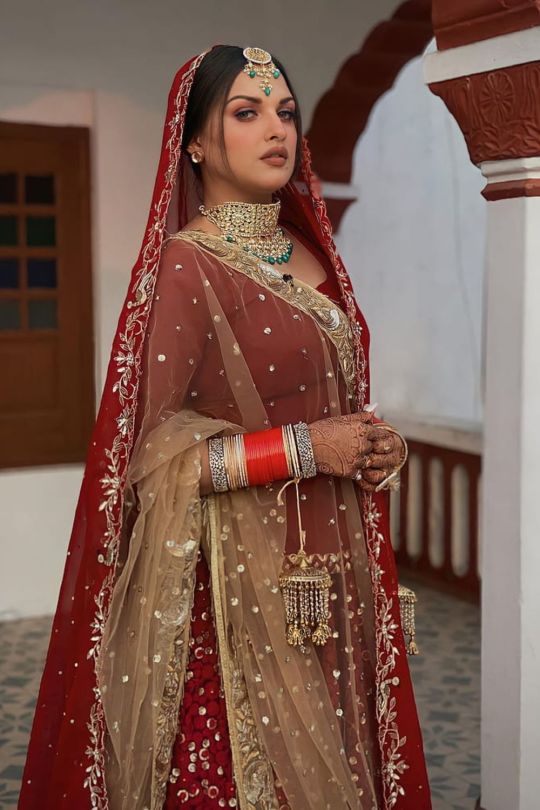
View On WordPress
6 notes
·
View notes
Text
Punjabi Power in Bollywood: Actors Who Made It Big in Hindi Cinema
The Indian film industry, particularly Bollywood, has seen an influx of talent from various regional backgrounds, with Punjabi actors making a significant impact. This article explores the rise of Punjabi actors in Bollywood, highlighting their contributions and successes, and how they have reshaped Hindi cinema.

The Influence of Punjabi Culture on Bollywood
Punjabi culture, known for its vibrancy and energy, has found a prominent place in Bollywood films. The infusion of Punjabi elements-be it music, dance, or storytelling-has enriched the cinematic experience, making it more appealing to a broader audience.
Key Characteristics of Punjabi Actors
Punjabi actors often bring unique qualities to their roles:
Charismatic Screen Presence: Their lively personalities resonate well with audiences.
Versatility: Many actors transition seamlessly between genres, from drama to comedy.
Musical Talent: A significant number of Punjabi actors are also singers, enhancing their appeal.
Notable Punjabi Actors in Bollywood
Several Punjabi actors have successfully crossed over into Bollywood, establishing themselves as household names. Here are some of the most influential figures:
1. Diljit Dosanjh
Diljit Dosanjh is arguably one of the most successful Punjabi actors in Bollywood today. He made his debut with Udta Punjab (2016), where he portrayed a police officer battling drug issues in Punjab. His performance was widely acclaimed and marked the beginning of his successful journey in Hindi cinema. Following this, he starred in films like Phillauri and Welcome to New York, showcasing his range as an actor.
2. Akshay Kumar
Though primarily known as a Hindi film star, Akshay Kumar's roots trace back to Punjab. Born Rajiv Bhatia in Amritsar, he has consistently delivered blockbuster hits across genres. His contributions to both comedy and action films have solidified his status as one of Bollywood's leading actors.
3. Neeru Bajwa
Neeru Bajwa began her career in Bollywood with Main Solah Baras Ki (1998) before making a name for herself in Punjabi cinema. Her return to Bollywood with films like Prince and Phoonk 2 showcased her versatility and ability to connect with diverse audiences.
4. Ammy Virk
Ammy Virk is another prominent name among Punjabi actors in Bollywood. Known for his musical talent and acting skills, he gained recognition through films like Qissa Punjab and later made his mark in Hindi cinema with Laal Singh Chaddha. His journey exemplifies the blend of regional talent transitioning into mainstream Hindi films.
5. Binnu Dhillon
Binnu Dhillon is celebrated for his comedic roles in Punjabi cinema but has also ventured into Bollywood with films like Yamla Pagla Deewana Phir Se. His unique humor and relatable characters have made him a favorite among audiences.
The Role of a Film Directory
A film directory serves as an essential tool for both filmmakers and audiences alike. It provides comprehensive information about actors, films, and industry trends. For those interested in exploring the contributions of Punjabi actors in Bollywood, utilizing a film directory can enhance understanding and appreciation of their work.
Benefits of Using a Film App
Film apps have revolutionized how audiences engage with cinema:
Comprehensive Databases: They offer extensive databases of films and actors.
User-Friendly Interfaces: Easy navigation allows users to find specific information quickly.
Regular Updates: Keeping track of new releases and actor profiles ensures fans stay informed.
The Future of Punjabi Actors in Bollywood
The future looks promising for Punjabi actors in Bollywood. As the industry continues to evolve, the demand for diverse talent is growing. Several factors contribute to this trend:
Increased Collaboration: More filmmakers are recognizing the value of regional talent.
Cultural Representation: Audiences are drawn to stories that reflect their backgrounds.
Global Reach: With the rise of digital platforms, Punjabi content is reaching international audiences.
Conclusion
Punjabi actors have undeniably made a significant impact on Bollywood, bringing their unique flair and cultural richness to Hindi cinema. As they continue to break barriers and redefine roles within the industry, it is clear that their influence will only grow stronger. For fans eager to explore this vibrant segment of cinema further, utilizing a film directory or a film app can provide valuable insights into the lives and careers of these talented individuals.
In summary, the journey of Punjabi actors in Bollywood is not just about individual success; it reflects a broader narrative about cultural exchange and representation within Indian cinema. As they continue to shine on the silver screen, these stars remind us that talent knows no boundaries, whether linguistic or regional, and that true artistry resonates universally.
0 notes